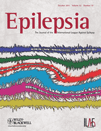Ictal high-frequency oscillations at 80–200 Hz coupled with delta phase in epileptic spasms
Summary
Previous studies of epileptic spasms reported that ictal events were associated with high-frequency oscillations (HFOs) or delta waves involving widespread regions. We determined whether ictal HFOs at 80–200 Hz were coupled with a phase of slow-wave, whether ictal slow-waves were diffusely or locally synchronous signals, and whether the mode of coupling between HFOs and slow-wave phases differed between ictal and interictal states. We studied 11 children who underwent extraoperative electrocorticography (ECoG) recording. The phases and amplitudes of slow-waves were measured at the peak of ictal and interictal HFOs in the seizure-onset sites. Ictal HFOs were locked tightly to the phase of slow-wave at ≤1 Hz. Ictal slow-waves propagated from the seizure-onset site to other regions. In contrast, interictal HFOs in the seizure-onset site were loosely locked to the phase of slow-wave at ≤1 Hz but tightly to that of ≥3-Hz. Ictal slow-waves coupled with HFOs can be explained as near-field and locally synchronized potentials generated by the neocortex rather than far-field potentials generated by subcortical structures. Ictal slow-waves in epileptic spasms may be generated by a mechanism different from what generates interictal HFOs–slow-wave complexes.




